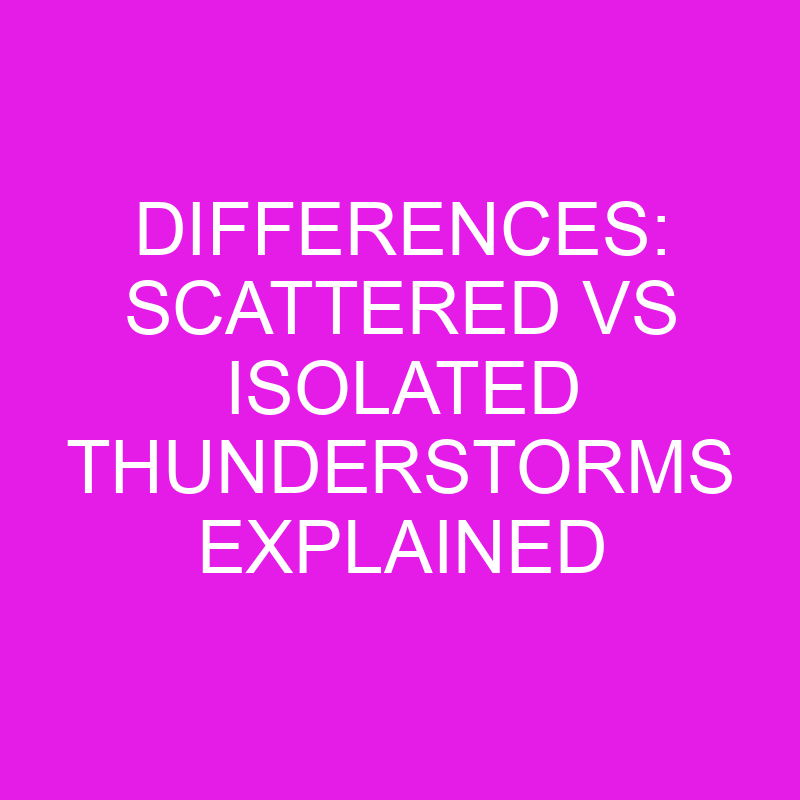
When it comes to weather forecasts, terms like “scattered thunderstorms” and “isolated thunderstorms” are often thrown around. But what exactly do these terms mean? And what sets them apart from each other? In this article, I’ll break down the key differences between scattered thunderstorms and isolated thunderstorms, helping you understand what to expect when you hear these terms in your local forecast.
Scattered thunderstorms refer to a weather pattern where thunderstorms are expected to occur, but they will not cover the entire forecast area. Instead, these thunderstorms will be scattered or spread out, with some areas experiencing stormy conditions while others remain dry. This means that not everyone will see a thunderstorm, but there’s a chance that you might encounter one if you’re in the right place at the right time.
On the other hand, isolated thunderstorms indicate a weather pattern where individual thunderstorms are expected to develop, but they will be few and far between. Unlike scattered thunderstorms, isolated thunderstorms are more limited in their coverage, with only a small number of areas experiencing stormy conditions. This means that the chances of encountering a thunderstorm are lower compared to scattered thunderstorms, but if you happen to be in the vicinity of one, you can still expect potentially intense weather conditions.
Post Contents
- What are Scattered Thunderstorms?
- Characteristics of Scattered Thunderstorms
- Impact of Scattered Thunderstorms
- What are Isolated Thunderstorms?
- Characteristics of Isolated Thunderstorms
- Impact of Isolated Thunderstorms
- Key Differences between Scattered and Isolated Thunderstorms
- Conclusion
- Frequently Asked Questions
- Q: What are the key differences between scattered and isolated thunderstorms?
- Q: Are isolated thunderstorms more severe compared to scattered thunderstorms?
- Q: How should I prepare for severe weather events like thunderstorms?
- Q: What hazards are associated with thunderstorms?
- Q: What will the next article discuss?
What are Scattered Thunderstorms?
Scattered thunderstorms are a common weather phenomenon that you might come across in weather forecasts. When forecasters mention scattered thunderstorms, it means that thunderstorms are expected in the area, but they will not cover the entire forecast region. Instead, they will be scattered or spread out, with some areas experiencing stormy conditions while others remain dry.
Scattered thunderstorms often occur when there is an unstable atmosphere, typically due to the presence of warm and humid air. The warm air rises and can create pockets of instability, which lead to the development of thunderstorms. However, the coverage of these thunderstorms is not widespread, meaning that the entire region will not be affected.
The scattered nature of these thunderstorms makes their forecast a bit tricky. While some areas may experience heavy rainfall, intense winds, and frequent lightning, other areas may only see a slight increase in cloud cover and minimal precipitation. It’s important to keep in mind that scattered thunderstorms do not mean constant rainfall throughout the day, but rather short-lived and localized storm cells.
Forecasters use various tools and models to predict the location and intensity of scattered thunderstorms. By analyzing atmospheric conditions, such as moisture levels, instability, and wind patterns, they can make informed predictions about where and when these storms may occur. However, the specific details of individual storm cells can be difficult to determine until they actually develop.
When encountering scattered thunderstorms, it’s important to stay informed about weather updates and take necessary precautions. Keep an eye on the sky and listen to local weather reports to stay prepared. If a thunderstorm is approaching your area, seek shelter indoors and avoid open fields, tall objects, and bodies of water.
Remember, scattered thunderstorms may not affect the entire region, but if you happen to be in the vicinity of one, be prepared for potentially intense weather conditions.
Characteristics of Scattered Thunderstorms
Scattered thunderstorms are a common weather phenomenon that can occur in various regions. Unlike isolated thunderstorms, which are more localized and occur in a specific area, scattered thunderstorms are more widespread and can affect larger portions of the forecast region. Here are some key characteristics of scattered thunderstorms:
- Variability: One of the main characteristics of scattered thunderstorms is their sporadic nature. They are not continuous throughout the forecast period or across the entire region. Instead, they are scattered or spread out, with areas experiencing stormy conditions while others remain dry. This variability makes it challenging to predict their behavior accurately.
- Unpredictability: While forecasters use advanced tools and models to predict the general area where scattered thunderstorms may occur, they can be unpredictable in terms of their exact location and intensity. Weather conditions can change rapidly, making it difficult to pinpoint where thunderstorm cells will develop and how severe they will become.
- Duration: Scattered thunderstorms typically have a shorter duration compared to isolated thunderstorms. They may last for a few minutes to a couple of hours before dissipating or moving out of the area. However, it’s essential to note that the duration can vary depending on the specific weather system and atmospheric conditions.
- Impact: The impact of scattered thunderstorms can vary from mild to severe. Some storms may produce heavy rainfall, strong gusty winds, and frequent lightning, while others may be less intense. Despite their scattered nature, it’s crucial to take necessary precautions when encountering these storms, as isolated cells can still pose risks to safety and property.
- Atmospheric instability: Like all thunderstorms, scattered thunderstorms occur due to an unstable atmosphere caused by warm and humid air. This instability allows for the development of updrafts and downdrafts, leading to the formation of thunderstorm clouds. The presence of strong updrafts can contribute to the development of scattered thunderstorms.
Understanding these characteristics of scattered thunderstorms can help individuals and communities stay informed about potential weather hazards. By remaining vigilant and keeping up with weather updates, people can take appropriate measures to ensure their safety during these unpredictable weather events.
Impact of Scattered Thunderstorms
Scattered thunderstorms can have a significant impact on the weather conditions in a given area. Their sporadic nature and variability make them a challenge to predict, and their effects can range from mild to severe. Here are some of the key impacts that scattered thunderstorms can have:
- Rainfall: Scattered thunderstorms can bring heavy rainfall within a short period. This can lead to localized flooding and make roads and streets hazardous. It is important to exercise caution and avoid driving through flooded areas during these storms.
- Strong Winds: During scattered thunderstorms, strong gusty winds are common. These winds can cause damage to trees, power lines, and structures. It is advisable to secure loose objects and stay indoors during gusty conditions to avoid any potential hazards.
- Lightning: Lightning is a major concern during thunderstorms. Scattered thunderstorms can produce frequent lightning strikes, which pose a significant risk to outdoor activities. It is crucial to seek shelter immediately when thunder is heard or lightning is seen, and to avoid open fields, tall structures, and bodies of water.
- Hail: While hail is more commonly associated with severe thunderstorms, it can also occur during scattered thunderstorms. Hailstones can vary in size, from small pellets to large, damaging chunks. It is important to find shelter during hailstorms to avoid potential injury.
- Tornadoes: Although less common than in severe thunderstorms, scattered thunderstorms can occasionally produce tornadoes. These can be particularly dangerous, causing significant damage and posing a threat to life and property. It is crucial to stay informed about any tornado watches or warnings issued by local authorities and to take immediate action to seek shelter when necessary.
It’s important to note that the impact of scattered thunderstorms can vary based on location and conditions. Staying informed through weather updates and following the guidance of local authorities is essential in ensuring your safety during these weather events.
What are Isolated Thunderstorms?
Isolated thunderstorms are weather events that occur in a localized area and are more limited in extent compared to scattered thunderstorms. While scattered thunderstorms can affect larger portions of a forecast region, isolated thunderstorms are confined to a smaller area. These storms are characterized by their isolated nature, meaning they are separated from other storms and are not part of a larger cluster or system.
During isolated thunderstorms, atmospheric conditions may be conducive to the development of thunderstorms in specific areas, but there is not a widespread pattern of storms across the region. Instead, these storms tend to form and dissipate relatively quickly, lasting for a shorter duration compared to scattered thunderstorms.
Even though isolated thunderstorms are smaller in scale, they can still pack a punch in terms of intensity. They may produce heavy rainfall, gusty winds, frequent lightning, and even small hail. However, because they are more localized, the overall impact of isolated thunderstorms is typically limited to the immediate vicinity where they occur.
It’s essential to stay informed about weather conditions, especially during isolated thunderstorms. Weather forecasts and updates from reliable sources can help you anticipate and prepare for these events. Local authorities may also issue safety guidelines or warnings, so it’s crucial to follow their guidance to ensure your safety during isolated thunderstorms.
Remember, while isolated thunderstorms are less widespread compared to scattered thunderstorms, they can still pose risks. Stay informed, be prepared, and prioritize safety during these weather events.
Characteristics of Isolated Thunderstorms
Isolated thunderstorms have their own unique set of characteristics that set them apart from other types of storms. Here are some important aspects to understand about isolated thunderstorms:
1. Localized Nature: Isolated thunderstorms occur in a specific and confined area, usually covering a relatively smaller region compared to scattered thunderstorms. While scattered storms can be widespread and affect a larger area, isolated thunderstorms are more restricted in their extent.
2. Formation and Dissipation: These storms form and dissipate relatively quickly. They tend to develop rapidly due to local atmospheric conditions, such as convective instability and moisture availability. However, their lifespan is typically shorter compared to other types of thunderstorms.
3. Heavy Rainfall: Despite their smaller scale, isolated thunderstorms can still produce intense precipitation. They are known for their ability to generate heavy rainfall within a localized area. This concentrated rainfall can result in localized flooding, especially in urban areas with poor drainage systems.
4. Gusty Winds: Isolated thunderstorms are often accompanied by strong and gusty winds. These winds are generated by the downdrafts associated with the storm. While the wind speeds may not be as strong as in severe thunderstorms or tornadoes, they can still cause damage to structures, trees, and power lines.
5. Frequent Lightning: Lightning is a common feature of isolated thunderstorms. The combination of convective uplift and moisture in the atmosphere creates ideal conditions for the development of thunderstorm clouds and the subsequent production of lightning. It is important to seek shelter indoors when lightning is present to avoid the risk of being struck.
6. Small Hail: Isolated thunderstorms can also produce small hail, which is formed when supercooled water droplets freeze in the storm’s updrafts. Although the hailstones may be small in size, they can still pose a threat to property, crops, and outdoor activities.
These are the key characteristics that define isolated thunderstorms. It is crucial to stay informed about weather conditions, especially during these localized storms, and follow the guidance of local authorities for safety.
Impact of Isolated Thunderstorms
Isolated thunderstorms may be small in scale, but they can still pack a punch. Here are a few ways these storms can impact our lives:
1. Heavy Rainfall: Isolated thunderstorms can produce intense rainfall in a short amount of time. This heavy downpour can lead to localized flooding, especially in areas with poor drainage. It’s important to stay aware of the weather conditions and avoid driving through flooded roads to ensure personal safety.
2. Gusty Winds: These storms are known for their strong and gusty winds. While the winds may not be as powerful as those in larger systems, they can still cause damage to trees, power lines, and outdoor structures. It’s a good idea to secure any loose objects or items that could be blown away by the wind.
3. Lightning Strikes: Isolated thunderstorms are often accompanied by frequent lightning. Lightning strikes can pose a significant risk to individuals, especially if they’re caught outdoors during a storm. It’s vital to seek shelter indoors and avoid open areas or standing near tall objects, such as trees or poles.
4. Small Hail: Though not as common as in severe thunderstorms, isolated thunderstorms can produce small hail. While small hail may not cause significant damage, larger hailstones can damage vehicles, windows, and crops. It’s advisable to find shelter indoors or seek protection in a sturdy vehicle during a hailstorm.
5. Disruption of Outdoor Activities: Isolated thunderstorms can disrupt outdoor activities such as sporting events, picnics, and outdoor gatherings. It’s essential to monitor weather forecasts and have a backup plan in case a thunderstorm is expected. Rescheduling or moving indoors may be necessary to ensure the safety of participants and attendees.
6. Electrical Power Outages: The combination of lightning strikes and gusty winds can increase the chances of electrical power outages during isolated thunderstorms. It’s advisable to have emergency supplies on hand, such as flashlights and batteries, in case of power loss. If an outage occurs, it’s essential to report it to the local power company for prompt restoration.
7. Impact on Wildlife and Environment: Isolated thunderstorms can also have an impact on wildlife and the environment. The heavy rainfall can alter ecosystems, leading to temporary changes in water levels and affecting the habitats of various species. Additionally, lightning strikes can start wildfires, posing a threat to vegetation and wildlife.
Key Differences between Scattered and Isolated Thunderstorms
When it comes to thunderstorms, there are various types that can occur. Two of the most common types are scattered thunderstorms and isolated thunderstorms. Although they may seem similar, there are some key differences between the two. Let’s take a closer look at these differences:
- Spatial Distribution: One of the main differences between scattered and isolated thunderstorms is their spatial distribution. Scattered thunderstorms are, as the name suggests, spread out across a larger area. On the other hand, isolated thunderstorms are more localized and tend to occur in a specific and confined area.
- Duration: Another difference lies in the duration of these storms. Scattered thunderstorms can last for several hours and may persist throughout the day. In contrast, isolated thunderstorms form and dissipate relatively quickly. They can come and go within a short period, making their impact more localized and short-lived.
- Coverage: Scattered thunderstorms cover a larger region, affecting multiple areas simultaneously. This means that there may be several scattered thunderstorms occurring in different locations at the same time. Isolated thunderstorms, on the other hand, are more isolated in nature and typically affect only one specific area.
- Intensity: While both scattered and isolated thunderstorms can be intense, isolated thunderstorms have the potential to be more severe. This is because they are often formed by localized atmospheric conditions that create a more intense and concentrated storm. It’s important to note that not all isolated thunderstorms will automatically be more severe than scattered thunderstorms, as the intensity can vary depending on the atmospheric conditions.
Understanding the differences between scattered and isolated thunderstorms is vital for being prepared and staying safe during severe weather events. By being aware of the spatial distribution, duration, coverage, and intensity of these storms, you can accurately assess the potential risks and take necessary precautions.
When it comes to personal safety, always follow the guidance of local authorities, stay informed about weather conditions, and seek shelter indoors if a thunderstorm is approaching. Keep in mind that thunderstorms, regardless of their type, can pose various hazards such as heavy rainfall, gusty winds, frequent lightning, and the potential for small hail.
Now that we’ve explored the key differences between scattered and isolated thunderstorms, let’s move on to discuss the impact that these storms can have on our daily lives and the environment.
Conclusion
Understanding the difference between scattered thunderstorms and isolated thunderstorms is crucial for staying safe during severe weather events. Scattered thunderstorms cover a larger area and can last for several hours, while isolated thunderstorms are localized and dissipate quickly. The concentrated nature of isolated thunderstorms makes them potentially more severe.
To ensure your safety, it is important to follow the guidance of local authorities and stay informed about weather conditions. Seek shelter indoors during thunderstorms to avoid the hazards they pose, such as heavy rainfall, gusty winds, frequent lightning, and the potential for small hail.
In the next blog post, we will explore the impact of these storms on daily life and the environment. Stay tuned for more insights on how thunderstorms can affect various aspects of our lives.
Remember, being prepared and informed is key to staying safe during severe weather events. Stay vigilant and take the necessary precautions to protect yourself and your loved ones.
Frequently Asked Questions
Q: What are the key differences between scattered and isolated thunderstorms?
A: Scattered thunderstorms are spread out over a larger area and can last for several hours, while isolated thunderstorms are more localized and form and dissipate relatively quickly.
Q: Are isolated thunderstorms more severe compared to scattered thunderstorms?
A: Yes, isolated thunderstorms have the potential to be more severe due to their intense and concentrated nature.
Q: How should I prepare for severe weather events like thunderstorms?
A: It is important to follow the guidance of local authorities, stay informed about weather conditions, and seek shelter indoors during thunderstorms.
Q: What hazards are associated with thunderstorms?
A: Thunderstorms can bring hazards such as heavy rainfall, gusty winds, frequent lightning, and the potential for small hail.
Q: What will the next article discuss?
A: The next article will discuss the impact of thunderstorms on daily life and the environment.






